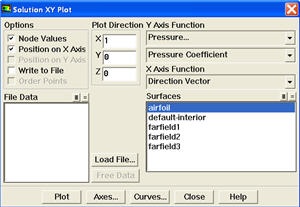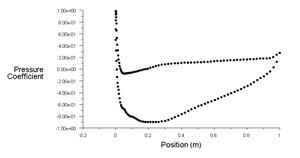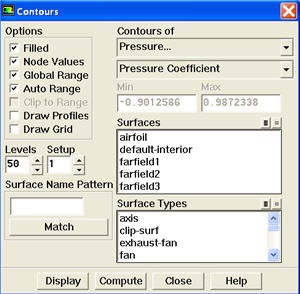Step 6: Analyze Results
Lift Coefficient
The solution converged after about 480 iterations.
| No Format |
|---|
476 1.0131e-06 4.3049e-09 1.5504e-09 6.4674e-01 2.4911e-03 0:00:48 524
! 477 solution is converged
477 9.9334e-07 4.2226e-09 1.5039e-09 6.4674e-01 2.4910e-03 0:00:38 523
|
From FLUENT main window, we see that the lift coefficient is 0.647. This compare fairly well with the literature result of 0.6 from Abbott et al.
Plot Velocity Vectors
Let's see the velocity vectors along the airfoil.
Display > Vectors
Enter 4 next to Scale. Enter 3 next to Skip. Click Display.
| newwindow | ||||
|---|---|---|---|---|
| ||||
| Wiki Markup | ||||
{panel} [Problem Specification|FLUENT - Flow over an Airfoil- Problem Specification] [1. Create Geometry in GAMBIT|FLUENT - Flow over an Airfoil- Step 1] [2. Mesh Geometry in GAMBIT|FLUENT - Flow over an Airfoil- Step 2] [3. Specify Boundary Types in GAMBIT|FLUENT - Flow over an Airfoil- Step 3] [4. Set Up Problem in FLUENT|FLUENT - Flow over an Airfoil- Step 4] [5. Solve\!|FLUENT - Flow over an Airfoil- Step 5] {color:#ff0000}{*}6. Analyze Results{*}{color} [7. Refine Mesh|FLUENT - Flow over an Airfoil- Step 7] [Problem 1|FLUENT - Flow over an Airfoil- Problem 1] [Problem 2|FLUENT - Flow over an Airfoil- Problem 2] {panel} h2. Step 6: Analyze Results h4. Plot Velocity Vectors Let's see the velocity vectors along the airfoil. *Display > Vectors* Enter 4 next to {color:#660099}{*}{_}Scale{_}{*}{color}. Enter 3 next to {color:#660099}{*}{_}Skip{_}{*}{color}. Click {color:#660099}{*}{_}Display{_}{*}{color}. \\ !velocity magnitude_sm.jpg! {newwindow: Higher Resolution Image}https://confluence.cornell.edu/download/attachments/90744040/velocity%20magnitude.jpg{newwindow} \\ As can be |
As can be seen,
...
the
...
velocity
...
of
...
the
...
upper
...
surface
...
is
...
faster
...
than
...
the
...
velocity
...
on
...
the
...
lower
...
surface.
| Tip | ||||||||||||
|---|---|---|---|---|---|---|---|---|---|---|---|---|
| =
|
|
|
|
| |||||||
| } To get white background go to: *
Menu > File > Hardcopy *
sure that {color:#660099}{*}{_}Reverse Foreground/Background {_}{*}{color}is checked and select {color:#660099}{*}{_}Color {_}{*}{color}in {color:#660099}{*}{_}Coloring {_}{*}{color}section. Click {color:#660099}{*}{_}Preview {_}{*}{color}. Click {color:#660099}{*}{_}No {_}{*}{color}when prompted " _Reset graphics window?" |
| newwindow | ||||
|---|---|---|---|---|
| ||||
_" {tip} \\ \\ !velocity magnitude leading edge_sm.jpg! {newwindow: Higher Resolution Image} https://confluence.cornell.edu/download/attachments/90744040/velocity%20magnitude%20leading%20edge.jpg{newwindow} \\ On the leading |
On the leading edge,
...
we
...
see
...
a
...
stagnation
...
point
...
where
...
the
...
velocity
...
of
...
the
...
flow
...
is
...
nearly
...
zero.
...
The
...
fluid
...
accelerates
...
on
...
the
...
upper
...
surface
...
as
...
can
...
be
...
seen
...
from
...
the
...
change
...
in
...
colors
...
of
...
the vectors.
| newwindow | ||||
|---|---|---|---|---|
| ||||
vectors. \\ !velocity magnitude trailing edge_sm.jpg! {newwindow: Higher Resolution Image}https://confluence.cornell.edu/download/attachments/90744040/velocity%20magnitude%20trailing%20edge.jpg{newwindow} \\ On the trailing |
On the trailing edge,
...
the
...
flow
...
on
...
the
...
upper
...
surface
...
decelerates
...
and
...
converge
...
with
...
the
...
flow
...
on
...
the
...
lower
...
surface.
...
| Info | ||
|---|---|---|
| ||
Do note that the time for fluid to travel top and bottom surface of the airfoil is not necessarily the same, as common misconception |
Plot Pressure Coefficient
Pressure Coefficient is a dimensionless parameter defined by the equation
| Latex |
|---|
where p is the static pressure,
Pref is the reference pressure, and
qref is the reference dynamic pressure defined by
| Latex |
|---|
The reference pressure, density, and velocity are defined in the Reference Values panel in Step 5. Please refer to FLUENT's help for more information. Go to Help > User's Guide Index for help.
Plot > XY Plot...
Change the Y Axis Function to Pressure..., followed by Pressure Coefficient. Then, select airfoil under Surfaces.
Click Plot.
| newwindow | ||||
|---|---|---|---|---|
| ||||
https://confluence.cornell.edu/download/attachments/90744040/pressure%20coefficient%20plot.jpg |
The lower curve is the upper surface of the airfoil and have a negative pressure coefficient as the pressure is lower than the reference pressure.
Plot Pressure Contours
Plot static pressure contours.
Display > Contours...
Select Pressure... and Pressure Coefficient from under Contours Of. Check the Filled and Draw Grid under Options menu. Set Levels to 50.
Click Display.
| newwindow | ||||
|---|---|---|---|---|
| ||||
https://confluence.cornell.edu/download/attachments/90744040/presssure%20coefficient%20contour%20plot.jpg |
From the contour of pressure coefficient, we see that there is a region of high pressure at the leading edge (stagnation point) and region of low pressure on the upper surface of airfoil. This is of what we expected from analysis of velocity vector plot. From Bernoulli equation, we know that whenever there is high velocity, we have low pressure and vise versa.
Go to Step 7: Refine Mesh
 Sign-up for free online course on ANSYS simulations!
Sign-up for free online course on ANSYS simulations!





